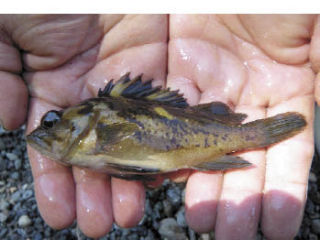By Russel Barsh and Madrona Murphy
Federal and state authorities recently agreed to further restrict harvests of rockfish in western Washington, citing evidence of the continued decline of all but one of the 14 rockfish species still found in the Salish Sea.
As their name implies, rockfishes prefer to hide and forage in complex rocky habitats, like the underwater pinnacles and rock piles that can be found throughout the San Juan Islands. Indeed, the islands have the lion’s share of rockfish habitat in western Washington, and as a result, the largest historical and current rockfish populations and the most important fishery. Rockfishes are year-round residents, and they are relatively easy to find and harvest with a hook and line. Islanders have understandably relied on rockfishes for food for thousands of years, second only to salmon.
Rockfishes are easily identified by their spiny dorsal fins, compact heavy bodies, and prominent eyes, which aid them hunting in deep waters far below the photozone, or in some rockfish species, at night. Young rockfishes feast on crab larvae and other small crustaceans, and as they grow older and larger, they add juvenile herring and other fish—including rockfish—to their diet. Rockfishes on the whole appear to eat whatever they can find and subdue in their individual territories, to which they will return faithfully even if removed and released miles away.
Rockfishes have similar life histories but vary greatly in coloration and fin shapes. Why are there so many species? Some rockfish diversity may be due to behavioral divergence, rather than functional specialization. Rockfish have been observed engaging in a leisurely ballet prior to mating. Many fish species engage in complex courtships, like birds, and like birds they tend to be brightly marked—or have distinctive feather arrangements—to recognize members of their own species. New species can arise from variations in courtship rituals, and selection for characteristics that help individuals find mates that speak the same ritual language.
The comparison with birds also extends to the tendency of rockfishes to form multi-species flocks. In our underwater studies of some of the less disturbed pinnacles in San Juan County, we often see mixed aggregations of Copper and Quillback rockfish. The purpose of rockfish flocks is not clear, but for many species of birds and fishes, large flocks tend to confuse predators, especially young inexperienced predators that have not yet learned to stay visually locked onto a single member of the flock. Lingcod are the most ferocious predator of rockfish in our waters (other than humans), but salmon have also been known to dine on rockfish.
Rockfish do have other defenses against predators. While their spines are not poisonous, they can be raised like a porcupine’s quills, make rockfishes very difficult for predators to swallow!
Adult rockfish can live for 30 years or longer, often reaching sexual maturity only at 10-15 years. Rockfish give live birth, and the tiny larval fish may become part of the plankton for some time before they move into shallow vegetated nearshore areas. Our community salmon research teams have found aggregations of very young Copper, Quillback and Black rockfish in water as shallow as one fathom, making them as vulnerable to shoreline development and altered beach processes as beach-spawning smelt or sand lance.
The fate of the islands’ rockfishes is still uncertain. Fishing pressure can be abated by new regulations, but we know much less about the extent of habitat loss, or changes in nearshore trophic webs that may also be contributing to rockfishes’ decline. With good will and considerably more local research and shoreline conservation, we may still look forward to enjoying the beauty and mystery of the islands’ rockfishes—and the tastiness of fresh local “red snapper.”
If you have been fishing for rockfishes in the islands for many years and are willing to share your knowledge of changes in the best fishing places for different species, Russel Barsh of Kwiáht and Anne Beaudreau of the University of Washington would like to hear from you! Contact Russel at RLBarsh@gmail.com.



